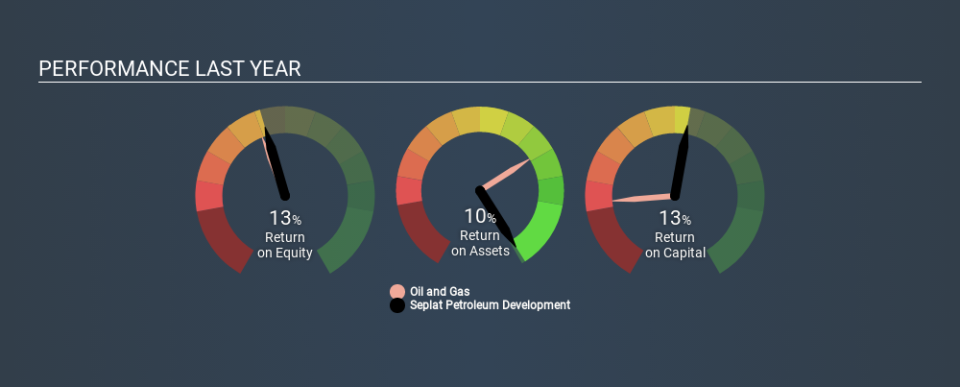What Can We Make Of Seplat Petroleum Development Company Plc’s (LON:SEPL) High Return On Capital?

Today we'll look at Seplat Petroleum Development Company Plc (LON:SEPL) and reflect on its potential as an investment. Specifically, we're going to calculate its Return On Capital Employed (ROCE), in the hopes of getting some insight into the business.
First up, we'll look at what ROCE is and how we calculate it. Next, we'll compare it to others in its industry. Then we'll determine how its current liabilities are affecting its ROCE.
What is Return On Capital Employed (ROCE)?
ROCE is a metric for evaluating how much pre-tax income (in percentage terms) a company earns on the capital invested in its business. All else being equal, a better business will have a higher ROCE. Ultimately, it is a useful but imperfect metric. Renowned investment researcher Michael Mauboussin has suggested that a high ROCE can indicate that 'one dollar invested in the company generates value of more than one dollar'.
How Do You Calculate Return On Capital Employed?
The formula for calculating the return on capital employed is:
Return on Capital Employed = Earnings Before Interest and Tax (EBIT) ÷ (Total Assets - Current Liabilities)
Or for Seplat Petroleum Development:
0.13 = US$297m ÷ (US$2.5b - US$292m) (Based on the trailing twelve months to September 2019.)
So, Seplat Petroleum Development has an ROCE of 13%.
See our latest analysis for Seplat Petroleum Development
Is Seplat Petroleum Development's ROCE Good?
One way to assess ROCE is to compare similar companies. Using our data, we find that Seplat Petroleum Development's ROCE is meaningfully better than the 9.9% average in the Oil and Gas industry. We consider this a positive sign, because it suggests it uses capital more efficiently than similar companies. Regardless of where Seplat Petroleum Development sits next to its industry, its ROCE in absolute terms appears satisfactory, and this company could be worth a closer look.
Our data shows that Seplat Petroleum Development currently has an ROCE of 13%, compared to its ROCE of 0.7% 3 years ago. This makes us think about whether the company has been reinvesting shrewdly. You can click on the image below to see (in greater detail) how Seplat Petroleum Development's past growth compares to other companies.
It is important to remember that ROCE shows past performance, and is not necessarily predictive. ROCE can be deceptive for cyclical businesses, as returns can look incredible in boom times, and terribly low in downturns. ROCE is only a point-in-time measure. Remember that most companies like Seplat Petroleum Development are cyclical businesses. Future performance is what matters, and you can see analyst predictions in our free report on analyst forecasts for the company.
Do Seplat Petroleum Development's Current Liabilities Skew Its ROCE?
Liabilities, such as supplier bills and bank overdrafts, are referred to as current liabilities if they need to be paid within 12 months. Due to the way the ROCE equation works, having large bills due in the near term can make it look as though a company has less capital employed, and thus a higher ROCE than usual. To counter this, investors can check if a company has high current liabilities relative to total assets.
Seplat Petroleum Development has total assets of US$2.5b and current liabilities of US$292m. Therefore its current liabilities are equivalent to approximately 11% of its total assets. Current liabilities are minimal, limiting the impact on ROCE.
The Bottom Line On Seplat Petroleum Development's ROCE
With that in mind, Seplat Petroleum Development's ROCE appears pretty good. Seplat Petroleum Development shapes up well under this analysis, but it is far from the only business delivering excellent numbers . You might also want to check this free collection of companies delivering excellent earnings growth.
If you are like me, then you will not want to miss this free list of growing companies that insiders are buying.
If you spot an error that warrants correction, please contact the editor at editorial-team@simplywallst.com. This article by Simply Wall St is general in nature. It does not constitute a recommendation to buy or sell any stock, and does not take account of your objectives, or your financial situation. Simply Wall St has no position in the stocks mentioned.
We aim to bring you long-term focused research analysis driven by fundamental data. Note that our analysis may not factor in the latest price-sensitive company announcements or qualitative material. Thank you for reading.

